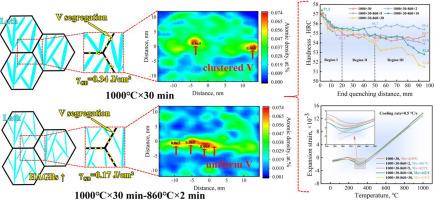通过调节晶界V分布提高中碳钢的淬透性
IF 14.3
1区 材料科学
Q1 MATERIALS SCIENCE, MULTIDISCIPLINARY
引用次数: 0
摘要
钒(V)晶界偏析已被证实能提高钢的淬透性,但如何最大限度地发挥钒(V)的作用,进一步改善钢的力学性能仍需不断探索。本研究采用两步奥氏体化等温工艺,研究其对v微合金钢(40CrNiMoV钢)淬透性和力学性能的提高效果。结果表明:与常规单步处理(1000℃ × 30 min)相比,两步奥氏体化等温处理(1000℃ × 30 min,然后是860℃ × 2 min)提高了试验钢的淬透性和力学性能。特定的两步奥氏体化等温过程,即经历第一步奥氏体化等温过程,然后冷却至860℃,等温保温2 min,促进了试验钢中V在晶界处的均匀偏析。这导致晶界能显著降低,从而稳定了奥氏体,延缓了α-相变,显著提高了淬透性。试验钢的特殊淬透性促进了处理后组织中高密度高角晶界的形成。此外,它细化了马氏体/贝氏体板条厚度。这种双重作用协同提高了试验钢的力学性能。本文章由计算机程序翻译,如有差异,请以英文原文为准。

Improved hardenability of medium-carbon steel by tuning V distribution at grain boundaries
Vanadium (V) segregation at grain boundaries has been proven to enhance hardenability of steels, while methods of maximizing the effect of V and further improving the mechanical properties of steels still need to be explored continuously. This study introduces a two-step austenitization isothermal process to investigate its effects on enhancing the hardenability and mechanical properties of V-microalloyed steel, i.e., 40CrNiMoV steel. The results demonstrate that the two-step austenitization isothermal process (1000°C × 30 min followed by 860°C × 2 min) enhances both the hardenability and mechanical properties of the test steel compared to conventional single-step treatment (1000°C × 30 min). The specific two-step austenitization isothermal process, i.e., undergoing the first step of the austenitization isothermal process, followed by cooling to 860°C and isothermal holding for 2 min, promotes the uniform segregation of V at grain boundaries in the test steel. This leads to a significant reduction in grain boundary energy, thereby stabilizing austenite and delaying α-phase transformation, which substantially enhances the hardenability. The exceptional hardenability of the test steel promotes the formation of a high density of high-angle grain boundaries in the post-treatment microstructure. Additionally, it refines the martensite/bainite lath thickness. Such dual effects synergistically improve the mechanical properties of the test steel.
求助全文
通过发布文献求助,成功后即可免费获取论文全文。
去求助
来源期刊

Journal of Materials Science & Technology
工程技术-材料科学:综合
CiteScore
20.00
自引率
11.00%
发文量
995
审稿时长
13 days
期刊介绍:
Journal of Materials Science & Technology strives to promote global collaboration in the field of materials science and technology. It primarily publishes original research papers, invited review articles, letters, research notes, and summaries of scientific achievements. The journal covers a wide range of materials science and technology topics, including metallic materials, inorganic nonmetallic materials, and composite materials.
 求助内容:
求助内容: 应助结果提醒方式:
应助结果提醒方式:


